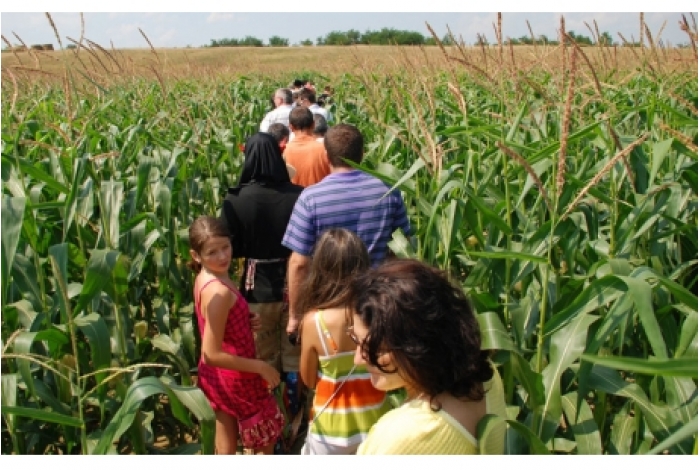The Dragus Corn Labyrinth
As urbanisation sweeps through Romania, many rural villages are struggling to survive. In order keep their hometown prospering, some of them are now turning towards tourism as a possible source of income.

The Dragus Corn Labyrinth. Photo by Ana A. Negru
How one traditional village is navigating its way through the tourism maze
As more and more people rely on large companies to provide goods and services, villagers are finding it difficult to earn a living through the customary trades of the countryside, such as farming or carpentry. Sadly, if such people cannot make a living then they must move to the city to find work, and thus person by person these small villages begin to disappear. Therefore in order to preserve the traditional way of life that still remains in the countryside, it is essential that villages are able to find new ways to thrive and survive. In order keep their hometown prospering, some villages are now turning towards tourism as a possible source of income. The question remains, however, how to tempt tourists to venture beyond the city limits and out into the countryside.
One town that is trying its hand at tourism is Dragus, a small village located about an hour and a half drive out of Brasov. It is a picturesque place, full of brightly painted homes and surrounded by green fields of crops, but it is nevertheless overlooked by those passing through Romania in favour of more well-known locations, such as Bran and Rasnov with their famous castles. Because of this need to encourage tourism, the mayor of Dragus, Gheorge Sucaciu, was eager to listen when approached by Nicolae Marghiol, the head of NGO ‘the Most Beautiful Villages in Romania’.
In the past Nicolae spent some time in small villages in Belgium, where he saw with his own eyes how the people there had succeeded in building an attraction that, while managing to lure tourists in from the city, did not compromise the traditional atmosphere of the village – corn labyrinths. Unable to find this kind of attraction in the city, tourists could happily travel to these small villages for the day as wandering a labyrinth is an activity that people of all ages could enjoy; adults for the scenic views and fresh air, and children for the fun of navigating their way through a maze. An added bonus was that this kind of attraction is easy enough to build in the countryside where corn fields were already growing, and unlike a gaudy theme park, it does not seem out of place in the village.
Of course, it was not all smooth sailing from the inception of the Dragus Corn Labyrinth right up until opening day. The actual construction of the labyrinth took five weeks, and required a lot of hard work from dozens of volunteers, spread out over the three hectares of land. At one point the future of the maze seemed bleak, as the corn crops were not growing large enough. Thankfully a large amount of fertilizer solved this problem, and on August 20th the corn labyrinth in Dragus was finally ready to be opened to the public.
I was lucky enough to be there for the inauguration of the labyrinth, and my first impression of the event was that there was a pleasantly festive atmosphere; the sights and sounds of the market and food stalls and the picnicking families that were all situated before the labyrinth reminded me strongly of the days of my childhood, when my family and I would spend our Saturdays at town festivals or local school carnivals. Everywhere was the excited chattering of children as they raced about and the general murmur of conversation as their parents, watching on with good humour, stopped to greet their neighbours.
Unsure of what to expect (this being my first visit to a corn labyrinth), I found myself pleasantly surprised, as the maze itself was carefully thought out to appeal to all ages. I watched as adults, in order to find the exit, would gather together in groups to read the questions on local history that were written on sign posts throughout the labyrinth. They would argue briefly over who was right, before choosing one of 3 answers which corresponded to a pathway for them to take; if they continued to answer correctly they eventually managed to escape the labyrinth. The children, however, paid no attention to finding an escape route and instead raced to the centre of the maze in order to meet the local actors dressed as fairy-tale characters. Soon enough, the children were assisting Prince Charming in rescuing the Princess chained to her chair, though rather than helping the Prince search for the key, most children spent their time squealing and running away in terror from the scary demon chasing them!
When asked about his hopes and ambition for the labyrinth, Mayor Sucaciu explained that while he had agreed to build this attraction in order to bring tourists to the area and thus benefit the local community, Sucaciu also wanted the locals to have something unique in their village. On the inauguration of the labyrinth I saw the tourists and local families who had flocked to Dragus, as well as having seen first-hand the personal touches locals had given the maze, such as questions about local history posted at every corner which (if answered correctly) would reveal the correct path to choose. I can personally vouch that in building this corn maze, the mayor of Dragus has fulfilled both of his wishes!
by Katherine Clinnick
Photos by Ana A. Negru





